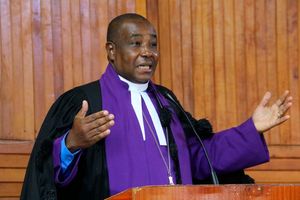Premium
There's more to the white cane than meets the eye

Arjaa Shah, the chairperson of Ayudh Kenya.
What you need to know:
- Worse because he will need a guide, and the dependence on a guide limits their freedom.
- Worse because an unfamiliar area poses a safety risk.
- And worse because the people he encounters may not believe that he is visually impaired.
Anytime you park your car on the sidewalk, dig a trench, leave a manhole open, or drop off a visually impaired person in an area that he is not familiar with, you are risking his life.
“We have trouble making our way when vehicles are parked on the sidewalk. Some are so high they hit our heads, and before my mind registers that the previously safe area I am used to walking on has a trench, I will have already fallen into it and gotten injured. What is normal for a person with good eyesight is a struggle for the visually impaired,’’ says Johnson Murungui Riungu, a teacher with Kenya Society of the Blind.
Even with a white cane that is designed to pick up vibrations and alert the user of the kind of ground, he is walking on, accidents, as Mr Riungu describes, happen. It would be worse, he explains, for a visually impaired person with no white cane.
Worse because he will need a guide, and the dependence on a guide limits their freedom. Worse because an unfamiliar area poses a safety risk. And worse because the people he encounters may not believe that he is visually impaired. The devastation, as Mr Riungu says, is worse for someone who once had good eyesight, but lost it along the way.
Lost his eyesight
Mr Riungu was born with sight, but developed cataracts, having his first eye surgery when he was five. Five years later, he suffered what doctors referred to as retinal detachment and ultimately lost his eyesight. For a year after that, he was in denial, and the adjustment that came with changing from a regular to a special school was overwhelming.
‘’At first, I didn’t want to use the aiding devices like a white cane because I did not believe I would never see again,’’ he says.
As the world celebrates the White Cane Safety Day today, Mr Riungu says that the white cane is necessary for the visually impaired because it is a symbol of independence.
World of touch
‘’I transitioned from a visual world to a world of touch. For me to understand what is happening, I need to hear, then touch. My white cane acts like an extension of my arm,’’ he adds.
Arjaa Shah, the chairperson of Ayudh Kenya, which runs the White C(R)ane Project that supports the visually impaired in Kenya, says every blind person should have a white cane.
Having had close friends who were visually impaired, her passion for helping the visually impaired in Kenya was fuelled by her desire to see them become independent.
“Ayudh is a Sanskrit term to mean peace. It is a call to action for youth around the world to come together to help each other. Ayudh Kenya was created in 2009 when Matthias Hofeld moved to Kenya from Germany. Visually impaired himself, and having received a lot of help from the German government, he was moved by the plight of the visually impaired in Kenya who had few to no white canes and aid,’’ says Miss Shah.
A white cane, she explains, may be significantly expensive for a visually impaired person, with each going for between Sh300 and Sh3,000.
When she took over as chairperson for the organisation in 2014, she sought funding to help distribute white canes to the visually impaired throughout the country. Each year, depending on the amount of funding she gets, she buys white canes, then partners with facilitators at Kenya Society for the Blind, Kenya Union for the Blind and county governments to get to the visually impaired in the grassroots.
“When the first case of Covid-19 was announced in the country in March, we partnered with facilitators from the government who were distributing care packages to the visually impaired. For every package, we gave a white cane, sometimes sending the canes through mobile courier services,’’ she says.
This year, she plans to distribute 20,000 white canes. According to 2018 annual report by Kenya Society for the Blind, an estimated 350,000 people are blind while another 750,000 are visually impaired. This means that Miss Shah’s efforts are just a drop in the ocean. Technology, observes Miss Shah, has contributed significantly to making the lives of visually impaired persons easier. There exist phones that are braille designed, and telecommunication companies that specifically register blind persons and offer special phone services.
“The main challenge, however, is that most organisations do not have the technological capacity to hire and keep visually impaired people. Our cultures also limit us to some extent. I have met a visually impaired child who was abandoned by his parents at the doorstep of a special school. The teacher had to take him in. I have also seen the limitations that the lack of a white cane has on every child and person with visual impairment in Kenya. We want to give them the freedom to be independent so that they do not have to rely on guides. As a normal person with sight, you do not need a guide to show you where to go, with a white cane, a vision-impaired person also does not require a guide all the time. Empowerment comes with tools and skills.”





